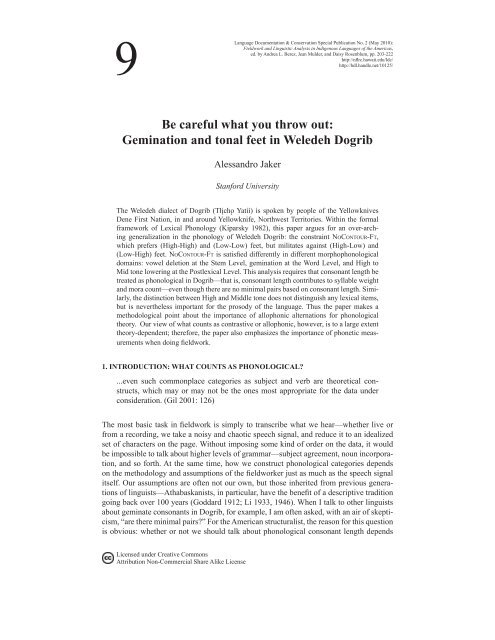Fieldwork and Linguistic Analysis in Indigenous ... - ScholarSpace
Fieldwork and Linguistic Analysis in Indigenous ... - ScholarSpace
Fieldwork and Linguistic Analysis in Indigenous ... - ScholarSpace
Create successful ePaper yourself
Turn your PDF publications into a flip-book with our unique Google optimized e-Paper software.
9<br />
Be careful what you throw out:<br />
Gem<strong>in</strong>ation <strong>and</strong> tonal feet <strong>in</strong> Weledeh Dogrib<br />
Aless<strong>and</strong>ro Jaker<br />
Stanford University<br />
The Weledeh dialect of Dogrib (Tłįchǫ Yatiì) is spoken by people of the Yellowknives<br />
Dene First Nation, <strong>in</strong> <strong>and</strong> around Yellowknife, Northwest Territories. With<strong>in</strong> the formal<br />
framework of Lexical Phonology (Kiparsky 1982), this paper argues for an over-arch<strong>in</strong>g<br />
generalization <strong>in</strong> the phonology of Weledeh Dogrib: the constra<strong>in</strong>t nocontour-ft,<br />
which prefers (High-High) <strong>and</strong> (Low-Low) feet, but militates aga<strong>in</strong>st (High-Low) <strong>and</strong><br />
(Low-High) feet. nocontour-ft is satisfied differently <strong>in</strong> different morphophonological<br />
doma<strong>in</strong>s: vowel deletion at the Stem Level, gem<strong>in</strong>ation at the Word Level, <strong>and</strong> High to<br />
Mid tone lower<strong>in</strong>g at the Postlexical Level. This analysis requires that consonant length be<br />
treated as phonological <strong>in</strong> Dogrib—that is, consonant length contributes to syllable weight<br />
<strong>and</strong> mora count—even though there are no m<strong>in</strong>imal pairs based on consonant length. Similarly,<br />
the dist<strong>in</strong>ction between High <strong>and</strong> Middle tone does not dist<strong>in</strong>guish any lexical items,<br />
but is nevertheless important for the prosody of the language. Thus the paper makes a<br />
methodological po<strong>in</strong>t about the importance of allophonic alternations for phonological<br />
theory. Our view of what counts as contrastive or allophonic, however, is to a large extent<br />
theory-dependent; therefore, the paper also emphasizes the importance of phonetic measurements<br />
when do<strong>in</strong>g fieldwork.<br />
1. INTRODUCTION: WHAT COUNTS AS PHONOLOGICAL?<br />
Language Documentation & Conservation Special Publication No. 2 (May 2010):<br />
<strong>Fieldwork</strong> <strong>and</strong> <strong>L<strong>in</strong>guistic</strong> <strong>Analysis</strong> <strong>in</strong> <strong>Indigenous</strong> Languages of the Americas,<br />
ed. by Andrea L. Berez, Jean Mulder, <strong>and</strong> Daisy Rosenblum, pp. 203-222<br />
http://nflrc.hawaii.edu/ldc/<br />
http://hdl.h<strong>and</strong>le.net/10125/<br />
...even such commonplace categories as subject <strong>and</strong> verb are theoretical constructs,<br />
which may or may not be the ones most appropriate for the data under<br />
consideration. (Gil 2001: 126)<br />
The most basic task <strong>in</strong> fieldwork is simply to transcribe what we hear—whether live or<br />
from a record<strong>in</strong>g, we take a noisy <strong>and</strong> chaotic speech signal, <strong>and</strong> reduce it to an idealized<br />
set of characters on the page. Without impos<strong>in</strong>g some k<strong>in</strong>d of order on the data, it would<br />
be impossible to talk about higher levels of grammar—subject agreement, noun <strong>in</strong>corporation,<br />
<strong>and</strong> so forth. At the same time, how we construct phonological categories depends<br />
on the methodology <strong>and</strong> assumptions of the fieldworker just as much as the speech signal<br />
itself. Our assumptions are often not our own, but those <strong>in</strong>herited from previous generations<br />
of l<strong>in</strong>guists—Athabaskanists, <strong>in</strong> particular, have the benefit of a descriptive tradition<br />
go<strong>in</strong>g back over 100 years (Goddard 1912; Li 1933, 1946). When I talk to other l<strong>in</strong>guists<br />
about gem<strong>in</strong>ate consonants <strong>in</strong> Dogrib, for example, I am often asked, with an air of skepticism,<br />
“are there m<strong>in</strong>imal pairs?” For the American structuralist, the reason for this question<br />
is obvious: whether or not we should talk about phonological consonant length depends<br />
Licensed under Creative Commons<br />
Attribution Non-Commercial Share Alike License

















